Ninety-five years ago today, the natives of the two small villages located in what is now Katmai National Park figured out what all the fuss had been about. For the past five days rumblings in the ground had shook their homes with increasing intensity, and the growing sense of foreboding was shared by even the birds who seemed uneasy and eager to leave. On July 6th, 1912 at about 1:00 PM Novarupta erupted, spewing hot ash and pumice into the air in what would stand as the largest volcanic eruption of the 20th century.
Novarupta left its legacy in the form of The Valley of 10,000 Smokes, a once fertile wetland that was smothered by a flow of ash 650 feet deep in some places. Despite the natural devastation to the entire Alaskan Peninsula and Kodiak Island- the death of wildlife, the suffocation of salmon streams, the destruction of habitat - the ecosystems of these areas were able to recover and rebuild within 5 years. The actual Valley, to this day, has not. When National Geographic explorer Robert Griggs first visited the Valley in 1918, it was covered with countless smoking fumaroles. He thought this was volcanic activity, and it was due to his lobbying that Katmai National Monument was created, to preserve what was thought of as a "future Yellowstone".
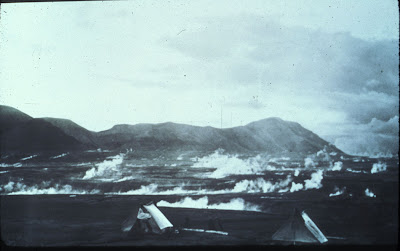
As it turns out the smoke was actually steam from the rivers that were boiling under the hot ash. The vents steamed for many decades, but today there are no more "smokes" in the Valley. There are also little signs of life; to this day it is a desolate wasteland of ash and pumice carved by treacherous rivers.

Our plan was to leave in the morning from the Park Service overlook, hike across and up the Valley, cross the River Lethe at some point, climb Baked Mountain and camp at the "Baked Mountain Huts" left there by the U.S. Geological Survey in the 1960s. The next morning we would hike through the saddle of Baked Mountain until we could see Novarupta, the site of the actual eruption, and then return to the huts to grab out gear before making the return hike through the valley and back to the overlook. It would be about a 25 mile journey in all.

There were nine of us and as you can see we were a motley crew. I looked out across the inhospitable terrain that we were attempting to cross (see above), finally turning my gaze to the twins (to my left), who were also contemplating our daunting journey. I considered their small frames and inexperience at backpacking, while they no doubt did the same with respect to me. Our gazes met, and it was at that moment we knew we were going to die out there.
By the time of the 1912 eruption, the people of the villages of Savonoski and Katmai had already fled, many to the nearby island of Kodiak. Within hours the ash cloud reached Kodiak, plunging the island into 3 days of darkness and crushing roofs under the weight of the fallen ash. 4 days later the cloud reached Virginia and after 10 days it was spotted over North Africa. The eruption was 100 times larger than Mt St. Helens. Despite stranded fishing boats, collapsed houses, pervasive darkness, and respiratory trouble, the resourceful natives all survived the blast. I was certain I would no be so fortunate.

Our first river crossing reinforced that certainty. My skinny white legs were no match for the cold waters of Windy Creek, but I admit that the loss of feeling in my feet and legs was rather peaceful. I hoped that the same feeling would come over my entire body prior to my inevitable demise in this godforsaken land.

After a half day of hiking we reached the River Lethe. Somehow we would have to cross this perilous gorge if the were to make it to the Baked Mountain Huts, and I knew from the lore of our park that river crossings were actually the most dangerous occurrence in Katmai. Some years ago an interp Ranger fell while crossing the Lethe; her body was never found (no kidding). A look at one of the twins' faces let me know that he too understood the futility of trying to escape this hell alive.
Obviously this was not the place to cross and so we followed the river for a few miles, coming across nothing but an alien land of rocky pumice and wet ash that our boots sank into. Father Hubbard, a Jesuit priest/explorer/professor of glaciers (again no joke), visited the Valley in the 1930s and called it "an abomination of desolation". This term was mentioned many times by either me or my fellows in doom, the twins, during our thankless hiking. At times it felt like I was walking on the moon, except of course Neil Armstrong lived to tell the tale.

Finally we encountered a sign of life: the tracks of a godless killing machine, the brown bear.

Doubtless it had moved ahead of us only to plan an ambush when we least expected. I took little comfort in the fact that I offered only a modest portion to the bear; after all there was more more meat on my bones than on one of the paltry twins.
I did not know whether my life would end at the claws of that ruthless assassin, the depths of the River Lethe, or the hands of my starving colleagues, but I was certain of one thing -- that I did not want to die without tasting beef jerky one last time, so we stopped to have lunch. Our packs still held food and water to sustain us, and so the inevitable drawing of straws was postponed to a later date.

Eventually we came to a point in the river where it widened out of the gorge and formed a shallow river still covered in ice in some spots. My party was hesitant to cross it for fear the the ice might give way, spilling them into the freezing and fast moving water below. Having already resigned myself to certain death, and wishing to arrive at the huts sooner than later so I could make myself some Ramen, I decided that there were worse ways to die than at the merciless whims of the Lethe the river god. So I crossed her at this point and my companions, still nervous due to my perceived lack of bulk, followed.
As night approached and the air turned wet, we reached the base of Baked Mountain. Looking up to the plateau we would have to reach to find the huts, my tired feet told me to give up and accept the inevitable, but I did not have a gas stove so I decided to follow the group lest I be forced to eat my Ramen uncooked.

Finally we reached the wooden USGS shacks that appropriately smelled like fuel inside. How ironic that we would survive the abomination of desolation we just hiked through only to die in our sleep inhaling gas fumes in an enclosed hut. But confoundingly I woke up in the morning, and so I started out towards Novarupta. The sight of that volcanic plug, the one thing in the Valley that is still smoking, made the trip worthwhile and I made a mental image in order to take it with me to the grave that I would certainly meet on the return trip.
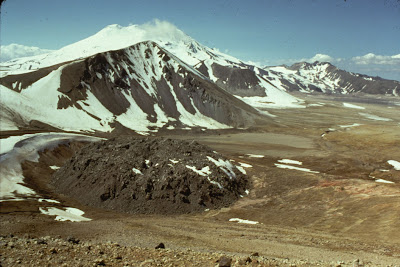
But astonishingly, and in no small part thanks to my unflagging heroism, we all escaped that abomination of desolation and made it back alive. We returned to the overlook to find that the ominous clouds had cleared to leave us with the best view of the Valley yet. We had hiked all the way to the snowy mountains in the background, through them to Novarupta, and back in 2 days.

The realization of my survival has not yet sank in, and from my face and those of the twins you can see we still wonder if the Expedition won't careen off the dirt road and down a mountain on our way back to camp.
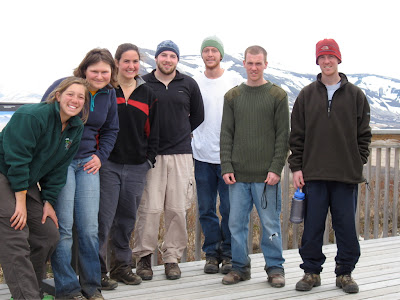
I hear that survivors of traumatic incidents often think this way, remaining in a state of heightened vigilance well after they are safe in an ambulance. In any case, I did make it back to camp and I will leave you with one more picture of those fragile legs that carried me the distance:

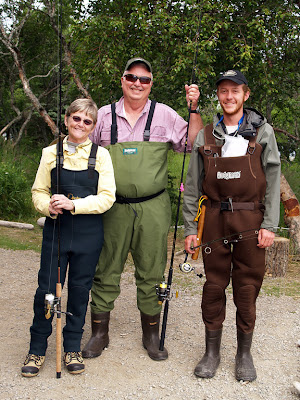
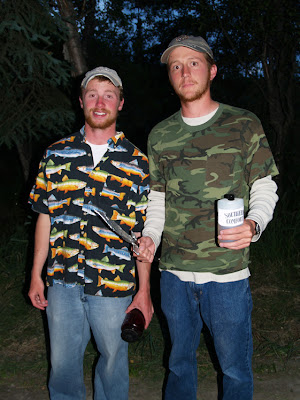













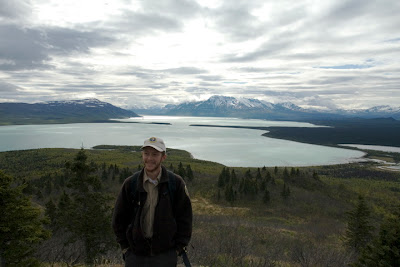

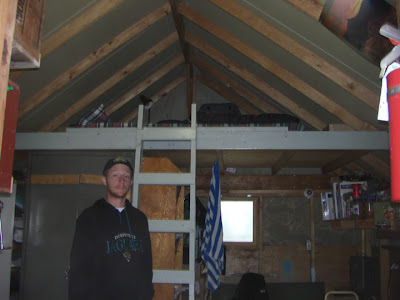





 Naknek Lake is in the foreground. On the right is Mt. Katolinat, seen up close here:
Naknek Lake is in the foreground. On the right is Mt. Katolinat, seen up close here:

 The above pictures were all taken from right out in front of camp on the beach of Naknek Lake. For some perspective, here is Katolinat and Naknek Lake from nearby Mt. Dumpling:
The above pictures were all taken from right out in front of camp on the beach of Naknek Lake. For some perspective, here is Katolinat and Naknek Lake from nearby Mt. Dumpling:
 You can see the tiny structures of our camp in the clearing below the mouth of the river. If you could zoom out and follow that river to the right, you would see where it flows from Lake Brooks:
You can see the tiny structures of our camp in the clearing below the mouth of the river. If you could zoom out and follow that river to the right, you would see where it flows from Lake Brooks:
